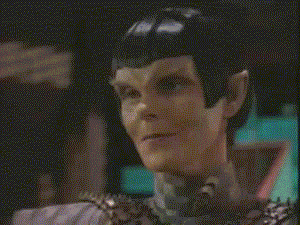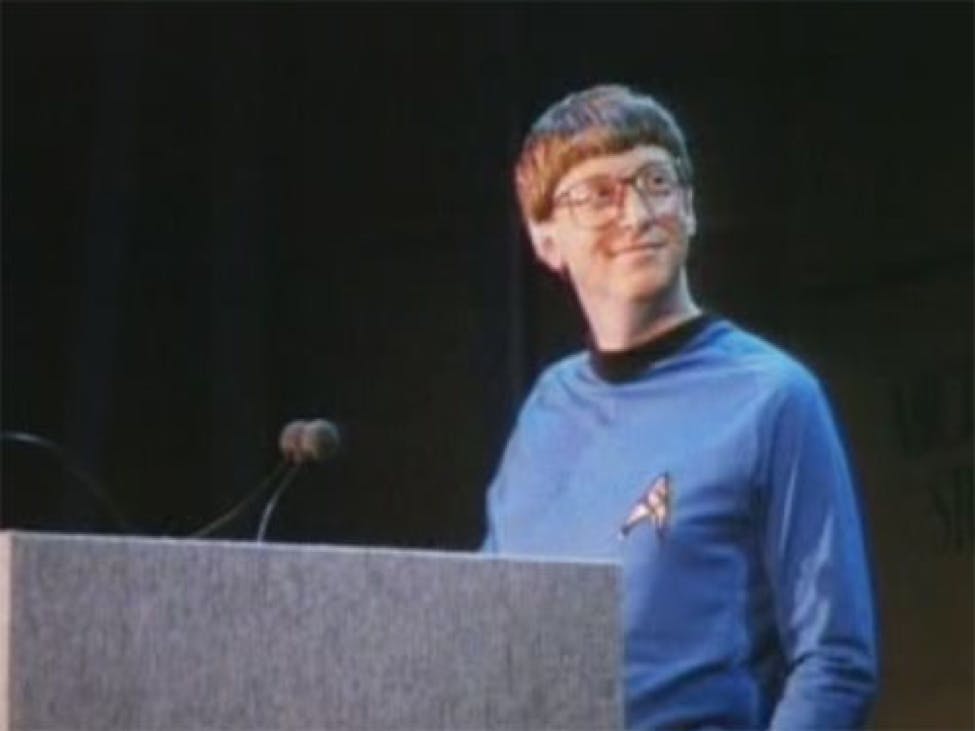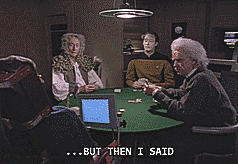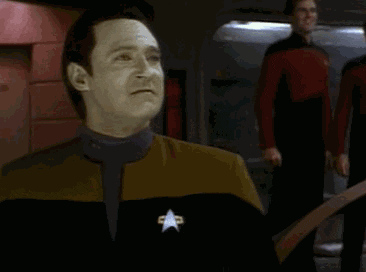When I was starting elementary school, my family moved from Los Angeles to Chicago. Entering a new school and neighborhood with existing cliques is difficult for a kid who is both new and also towers over everyone in their class; by the end of 5th grade, I was 5’11”.
At home, we had two TVs in my house, a nice one in the living room and an old set in the basement. Every Sunday, my parents would watch 60 Minutes and Murder She Wrote. When I was 11 or 12, I got to go downstairs on those Sunday evenings and watch whatever I wanted. What I saw on that old basement TV would forever change me: Star Trek.

I was already a computer nerd, having built multiple computers at this point and learned to program in multiple languages, so to see my passion for technology validated at this age by what the future could look like was overwhelming.
An Android!? Aliens? Working in harmony with technology to promote unity? As a kid who had to defend himself from bullies, Star Trek was the safety blanket I didn’t know I needed. It may seem corny to some but this had a profound effect on the direction of my life.
Star Trek changed the world for the better. Aside from showing us a peaceful future, several technological advancements have been inspired by this show and its franchises.
This article is a look at a few of those scientists, engineers, organizations and projects that move society forward and how Star Trek is credited as inspiration and deeply influential in their lives.
Star Trek is integrated into almost every aspect of society and technology. Legions of fans out there help keep the dream of future peace and space travel alive for the next generation and beyond. Even my 4-year-old daughter knows who Kirk, Spock and Bones are and why they’re heroes to so many people.
Andy Grove, Apple and the Pathway to Mac and PC Harmony
If you’re unsure of who Andy Grove is, I’m going to need you to turn in your official Nerd Card at the next meeting. As one of the founders of Intel, he pioneered the microprocessor, drove the growth phase of Silicon Valley, advised Steve Jobs and was even Time’s Man of the Year in 1997! To call him a technology giant is an understatement.
In 1992, Apple had a problem. Microsoft released Windows 3.1 and was in the process of changing personal computing forever. Windows was more versatile than Apple’s current offering because computer manufacturers could use Windows for their computers. As well, it ran on Intel processor architecture, which was less expensive than Apple’s proprietary built computer. Microsoft was turning into the juggernaut we came to know, and global sales were exploding.
At this point, Apple got interesting advice from an executive at Novell. Novell, a major player in network operating systems at the time, proposed to the current CEO of Apple (Steve Jobs was fired earlier) that Apple should port their operating system to Intel hardware, thus bringing them in line with Microsoft, lowering their cost and potentially making Apple’s MacOS compatible with Windows.
Andy Grove loved this idea and lent his expertise to the project. He too feared the monopoly that Microsoft was becoming. On Valentine’s Day in 1992, Apple set a Halloween deadline.
The project name, you ask? STAR TREK! MacOS 7 was going to go where no other MacOS had gone before. And they did it! They hit the deadline, booted up their prototype into a regular PC and made it work. This was the game changer that Apple needed to compete with Microsoft for lucrative manufacturer deals for PCs.


So why, dear reader, did we not see an Intel-based Apple OS until 2005? You can thank a Romulan for this one. As the Star Trek project was finally getting legs and proving itself, with the full backing and support of Andy Groves, Apple shelved the project.
Apple hired a new CEO, Michael Spindler, and he had no interest in a project that could have changed the competitive market forever.
Andy Grove was deeply disappointed for years; he relished competition. Having two major operating systems competing on a standardized hardware platform he helped invent must have been a letdown as he watched Microsoft take over the world.
That said, he did cathartically witness Apple adopt Intel as its platform, but by then Microsoft dominated the PC market. Sadly, he passed away earlier this year at age 79; his vision will be sorely missed. Like so many others, Groves was a Star Trek fan and his vision for a unified platform for Microsoft and Apple to share was brilliant and farsighted. Too bad it didn’t come to fruition.
Bill Gates and the Obsession with Spock
While most of us bow down and worship at the altar of Roddenberry (true nerds get that), there are two icons that most of us agree are the foundation of nerd culture: Bill Gates, patron saint of nerdly success (or the devil for some), and Mr. Spock, patron saint of logic.
I can’t walk through a data center without seeing Star Trek, specifically Spock (sometimes Scotty), paraphernalia around. Pictures attached to cages, action figures standing on server racks as if to bless the processors inside while they’re crunching data and delivering error free results. This is as close to superstition as we get in the IT world.
Love him or hate him, Bill Gates is… Bill Gates. Does he need describing at this point? What many don’t know is that Bill Gates loves Star Trek. Like us lesser nerds, he has enjoyed a good Star Trek episode (or three) in his day.

In fact, when he was younger, launching operating systems and still leading the charge on a day-to-day basis at Microsoft, he was a huge Spock fan.
How do I know this? Because to market a Windows launch he dressed up as Spock, ears and everything, and went out on stage, as seen in this image.

You can’t hide it, Bill. We know you’re a Trekkie, and we definitely know that Spock’s logic is an influential force in the development phase of any software project.
The “Hawk” is a Huge, Huge Fan!
Most Star Trek fans love science. My father once told me that “science is the expression of the capabilities of the human mind.” I don’t know if that quote was his or not, but 7-year-old Nick refuses to Google this one to confirm. It has stuck with me all these years and I believe there is no problem humanity can’t solve with science.
In terms of pure science, there are few people more revered than Stephen Hawking. Few scientists are as fun-loving as him. He is not just a brilliant mind; he’s a pop culture icon. Recently he’s appeared in the TV comedy Big Bang Theory and was even parodied in a rap battle. Any Star Trek fan knows that he had a cameo in Star Trek: The Next Generation. He was part of a poker game between Lt. Commander Data, Sir Isaac Newton and Albert Einstein. Spoiler Alert: the winner is the science fan!


He was invited to the show not simply to round out a poker game. It’s his favorite TV program! Further, he was inspired by Star Trek to help move humanity to the stars. While being interviewed about his appearance on Star Trek, and while he was being given a tour of the set of the Starship Enterprise, he paused at the warp engine, smiled and said, “I’m working on that.”
He may be standing on the shoulders of giants, but it would appear he hopes a spaceship gets him up there.
Martin Cooper and the Dream of Instant Communication
We owe a debt of gratitude to Martin Cooper. Do you like Pokémon Go? How about getting an email from anywhere on the planet? Heck, what about just being able to make a phone call without having to walk to a phone tethered to a wall? Martin Cooper made this possible. He invented the first mobile telephone, the foundation of all mobile communication and data today.
Yes, many articles celebrate that the cell phone is basically a Star Trek communicator. However, few talk about Martin Cooper and his inspiration. Cooper was a diehard Trekkie. He was working for Motorola at the time, and when he saw Captain Kirk talk to his ship with his Starfleet-issued communicator, Cooper came up with the idea of turning the telephone into a mobile device and began working on it with the blessing of Motorola. Shortly after, AT&T began their rival project led by Joel Engel. Engel would become the Captain Kang to Martin Cooper’s Kirk.
Cooper made the very first cell phone call in history at a press conference in 1973, and with Kirk-like confidence and swagger, he called Joel Engel! I can only presume a box of tribbles was also sent to AT&T.

NASA and the Desire to be Starfleet
The existence of NASA-loving Star Trek nerds should come as no surprise to anyone. How could they not view Star Trek as an essential blueprint for the future? What you may not know is just how deep the obsession goes.
For the record: Star Trek actors, elements and creator Gene Roddenberry all have asteroids named after them. Yes, an asteroid named “Spock” could kill us all. Currently, there are at least eight asteroids floating around out there with Star Trek-related names!
The first space shuttle orbiter was named Enterprise. This was inspired by the show and named for the NCC-1701 Enterprise in Star Trek. After 16 different flights or missions, it was retired and sat in the Smithsonian for years until being moved in 2012 to the Intrepid Sea, Air & Space Museum in New York City.
NASA is continuously putting on competitions for budding scientists, and many of these are Star Trek-related. The latest one was a challenge to try and create a Star Trek-based replicator. This technology, if perfected, could change the world for the better.
NASA is constantly writing articles that revolve around Star Trek and their personnel. A recent one lets us, the humble non-rocket scientists of the world, know just where the actual rocket scientists would go if they could in the Star Trek universe. Take a guess, but the number one answer should be rather obvious!
If the above didn’t convince you, NASA just threw a Star Trek social for the general public.

Boldly Inspiring Leaders
We are better off as a civilization because of the vision of Star Trek. Yes, we have cooler gadgets now, with more being developed, but Star Trek has done much more for us. It has inspired some of our best minds to push innovation. The examples above underscore that a future of peace can be achieved when humanity unites for the greater good.
Star Trek in our society isn’t only about the gadgets and tools that advance us. It’s about the inspired leaders all around us. Andy Grove saw a way to bridge the gap between two rivals. Martin Cooper made the world just a bit smaller by giving us the freedom to communicate anywhere. NASA looks to the future where all of humanity can reach for the stars and Bill Gates, well, I think Bill just really likes the Spock ears. However, Gates’s philanthropy and desire to innovate solutions for those in need is unparalleled in our history and keeping within the vision Gene Roddenberry had for humanity.
The world continuously becomes a better place despite our problems, and Star Trek is the perfect example of where we can be if we simply look towards a better future in peace.
